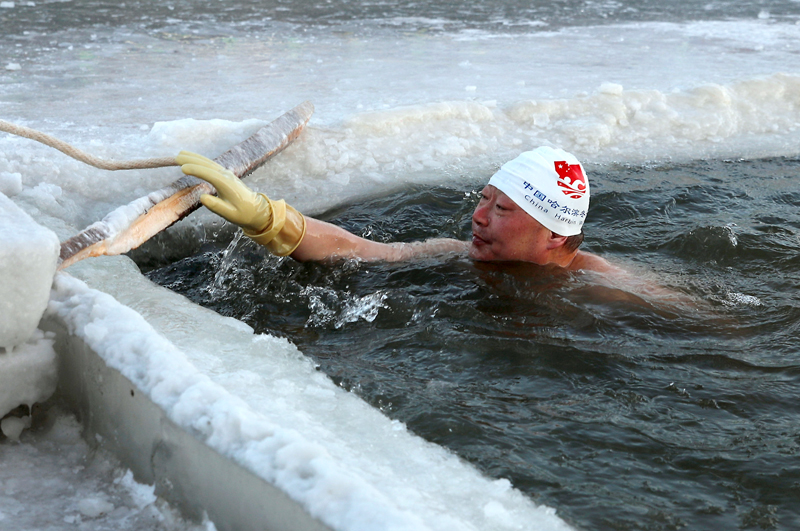You are viewing 1 of your 1 free articles. For unlimited access take a risk-free trial
Cold weather training: what your mother forgot to tell you!
Why does getting chilled to the bone or soaking wet during a winter workout seem to increase your risk of catching a cold, even though you know logically that colds result from exposure to viruses, not cold, damp air? Why does exercising in the cold increase your risk of having a heart attack compared with exerting yourself under temperate conditions? Why does cold weather exercise tend to clip corpulence from your body which might not fall during the summer?
To answer these questions correctly, you have to understand that your physiological responses to exercising in cold air are different from those that prevail under more moderate conditions. For example, researchers at Japan's National Defence Medical College have shown that exposure to cold air enhances the activity of 'suppressor macrophages' - large white blood cells which actually depress immune system functioning. The mechanism underlying this negative change may involve hydrocortisone (cortisol), a hormone produced by the adrenal glands in response to cold stress which tends to 'turn down' immune system activity. This somewhat perverse macrophage behaviour may explain, at least in part, why 'getting chilled' during a workout seems to increase your risk of getting ill; by contrast, overheating per se does not augment your chances of coming down with a viral infection.
Fortunately, the Japanese research mentioned above also suggests that continued training under cold conditions tends to blunt this suppressor-macrophage response (1): in other words, athletes who train regularly in cooler air (or in cold water) are less likely to experience downturns in their immune systems after workouts than those who are exposed to the cold only sporadically.
Although you may have known that exercising while exposed to wintry winds slightly increases your chances of catching a cold, you probably didn't know that it raises your risk of cardiovascular problems. But, in fact, various epidemiological studies have shown an increase in both fatal and non-fatal exercise-related myocardial infarctions (heart attacks) during periods of colder weather. Researchers aren't exactly sure why cold air is worse from this point of view than Bermuda breezes, but cold-air exposure is known to raise both the heart rate and arterial blood pressure, so increasing the stress on the heart. Human blood also clots more easily in cold weather, which might increase the risk of a coronary artery blockage. These changes are modified by frequent exposure to the cold, so it is probably sudden and unexpected or sporadic interactions with cold which carry the most risk (2).
How cold empties glycogen stores
A unique aspect of exercising in the cold is that it can - somewhat paradoxically - produce both glycogen depletion and high rates of fat metabolism. The glycogen depletion is caused by two factors: first shivering, which causes muscles to empty their glycogen stores at 5-6 times the normal rate; secondly, increased blood levels of epinephrine (adrenaline), a hormone which stimulates glycogen breakdown.
This high rate of glycogen usage tends to empty out muscle glycogen depots, forcing muscles to turn to fat as a source of energy. Epinephrine can also enhance fat metabolism, and there is some evidence that insulin levels are lower during the winter time, an effect which could also spur fat breakdown. Thus, colder portions of the year can be an excellent time to lose weight and improve body composition, especially since the cold also tends to raise one's resting metabolic rate. Additionally, exercising in the cold is often associated with an increased energetic cost of movement which can help push you into a 'negative energy balance' (3).
There is some evidence, albeit controversial, that winter exercise not only makes a sizable dent in your fat stores, but also helps to shed your most dangerous fat - the lard which is inside your body cavities, clinging to your internal organs. It is this deep, internal fat, not the tallow perched under your skin, which is most closely linked to high blood-fat levels and depressed concentrations of the protective high-density lipoprotein (HDL) cholesterol. Why is deep fat so hazardous? When fat cells inside your abdominal cavity release fat into the blood, the fat moves directly to your liver, where it can be transformed quickly into VLDLs and LDLs - the 'bad' fats which are associated with an increased risk of coronary artery disease. On the other hand, the fats inside your muscles and under your skin have a decent chance of being broken down by your muscles before they reach the liver. As athletes' muscles gobble up this fat, blood concentrations of HDL cholesterol tend to rise.
Are there special workouts which can enhance fat breakdown during the cooler part of the year? Basically, 60-minute bouts of exercise in nippy air, during which you attempt to push up the intensity a little rather than just poking lethargically along, are fantastic for breaking down fat, and slight adjustments in your workout schedule can also force the fat-burning fires to kindle with particular intensity. One useful strategy is to exercise for about an hour in the evening after dinner, refrain from eating afterwards, then complete another 60-minute bout of strenuous exercise on the following morning before breakfast. Your muscles will be quite glycogen-depleted during the sunrise session, causing fat to be metabolised at a higher rate than usual. This strategy also works during warmer parts of the year, but the unique nature of cold weather running may tend to magnify fat utilisation. Don't try this night-morning combo unless you are well-rested and feeling good, however.
Of course, one of the dangers of cold weather workouts is that you can sometimes get too cold. The danger does not arise from the frosty air per se but from the combination of frigid air and sweat. Cold air doesn't shut down the sweating process, and you begin to lose heat at an accelerated rate as your clothing becomes saturated with moisture. Water is a terrible insulator (it conducts heat away from the body about 25 times faster than air), so sweat-soaked clothes can transform an initially comfortable run into what feels like an arctic expedition. This can be especially dangerous if fatigue or injury produces a sudden downturn in running velocity.
I learned this the hard way last winter. During a long run, I was cruising along deserted country roads about six miles from my home in mid-Michigan when I suddenly heard ripping noises in one of my calf muscles. Within moments, I was transformed from a wet-yet-warm-as-toast runner into a shivering, hobbling walker, and I barely made it back to the house before becoming hypothermic. After a three-hour de-icing period, I emerged from beneath several layers of woollen blankets resolving to tie an extra-thick sweatshirt around my waist during all subsequent wintry excursions. It is true that English weather tends to be milder than our Michiganian (yes, that's a real word!) climate, but it is still possible to get into trouble with the cold on your 'fair isle'. How cold do you have to get before significant health problems occur? Well, I'm not fond of taking rectal temperature, but it's important to note that you'll die if your rectal temperature dips to around 75deg F, and putting on an extra pair of shorts or a layer of wool on your bottom won't protect you, since rectal temperature is simply a good indicator of overall body temp, not a precious commodity in its own right. In fact, once your body temperature falls below just 94deg F, your hypothalamus (a small part of your brain directly above your pituitary gland) loses its ability to regulate your body temperature and your problems really begin to accelerate. For each 10deg C drop in body temperature, metabolic reaction rates dip by about 50%, and drowsiness and coma result.
our best protection against this sort of problem is to tie an extra sweatshirt around your waist and keep a couple of quid in your pocket to pay for transport home!
Wind speed is a major factor
Do bear in mind that the actual coldness of a particular winter day depends not just on temperature but on wind speed, too. A moderately pleasant 5deg C temperature will suddenly feel like 0deg C if a 9 mile-per-hour wind develops, and the perceived coldness will plummet to about minus -5deg C with a 19 mph wind. It's important to remember that running itself can amplify or minimise this 'wind-chill' effect. For example, running at 10 mph into a 9 mph wind provides the same chill as standing still in a 19 mph gale. For that reason, on windy winter days it is important to complete the first half of all your runs into the wind. The second half of the run - when fatigue is slowing you down, your body is generating less heat and your clothes are wet with sweat - should be completed with the wind at your back. Running at 8 mph with an 8 mph wind behind you totally eliminates any wind-chill effect, whereas running at the same speed into an 8mph wind produces the chilling effects of a 16-mph squall.
Athletes sometimes ask whether breathing in large amounts of cold air could 'freeze' the respiratory tract. The answer is not entirely clear, but the risk appears to be quite low if you are able to pull most of the incoming air through your nose rather than your mouth. Bear in mind that even when the outside air is about 13deg F, inward-moving air is warmed to about 59deg F by the time it has moved just two inches into your nasal passages. By the time it reaches your larynx, it is close to 70, and the news is even better at the entry to your lungs, where the temperature of the in-rushing air is up to 86.
Does your body make an effort to acclimatise to the cold? As we've already seen, it does make adjustments so that immune system function doesn't fall off too much, blood pressure doesn't soar too high, and fuel availability is ample. However, research in this area has been somewhat limited, so the whole process is not completely understood, and reactions to cold exposure can be quite variable. For example, although exercise in cold air seems to help get rid of fat, daily exposure to cold water seems to enhance the production of subcutaneous body fat, an effect which would not only decrease bodily heat loss but also make the body more buoyant. Outside the water, much of our knowledge of cold acclimatisation has come from the study of Australian aborigines, many of whom can sleep quite comfortably outside on frigid nights without protection - and without a drop in body temperature. Research shows that Europeans reposing under similar conditions tend to experience extreme distress and lose body warmth readily. The mechanism underlying the aboriginal adaptation is not exactly clear but seems to involve an increased production of metabolic heat.
The bottom line? Cold weather exercise can be tough, but it can do great things for you. Winter is a perfect time to carry out lots of endurance-building, fat-burning, body composition-improving prolonged workouts. Your cold weather training will eventually lead to some really sizzling efforts when warmer weather arrives.
Cold weather coping tips
* Don't reduce your fluid consumption. It's true that sweating rates are lower in the cold than in the heat, but cold weather exercise can still be dehydrating. For one thing, water is lost from the respiratory system at an augmented rate on chilly days, and exposure to cold air can also increase urine production. Since feelings of thirst are diminished in cool air, the end result can be a dehydrated state which damages your performance and makes it harder to stay warm. The solution? Take in a glass of fluid immediately before a wintry workout and sip hot beverages immediately afterwards. Additionally, drink at least 8-10 glasses of water each day.
* Do consume extra carbohydrate. Cold exposure increases the rate at which muscles use up their carbohydrate stores, so glycogen depletion can become a problem. Winter also increases fat oxidation, but extra dietary fat is unnecessary. Even very lean athletes usually have enough fat stored in their bodies to support an increased utilisation of fat for fuel.
* Don't overeat. Amplifying the fat under your skin offers no special advantages. It's true that a fat person will feel more comfortable than a skinny individual when both are standing still in cold air, but the situation is reversed during exercise. Lean people can usually exercise more intensely than heftier folk and can therefore generate more internal heat. If your goal is to stay warm while exercising, being fit is definitely better than being fat! The exception to this rule is swimming, where a bit of suet under the skin prevents heat from being lost too rapidly to the water.
* If you are a runner, use at least two different pairs of running shoes. The running-shoe companies are very happy with this tip, which arises from the fact that winter's slushy conditions often leave running-shoe midsoles saturated with moisture. Wet midsoles absorb shock less well than dry soles, so leave water-logged shoes to dry out for 48 hours and use your second pair for the next day's run.
* Wear adaptable clothes during runs. Clothes with zippers are great, because you can open them up if you get too hot midway through a workout. Unzipping garments also gets rid of excess moisture which builds up as you move around. In general, wear enough clothing to stay warm as you exercise but not so much that you begin to sweat heavily. On the other hand, be prepared for the possibility of chilling: wear a sweatshirt with a hood which can be pulled up over your head if needed, and keep a spare item of clothing tied around your waist or at a pick-up point midway through your training session.
* During extremely cold weather, find sheltered exercise locations which are at least partly out of the wind. This will allow you to exercise more efficiently and reduce your risk of getting excessively cold.
Owen Anderson
Newsletter Sign Up
Testimonials
Dr. Alexandra Fandetti-Robin, Back & Body Chiropractic
Elspeth Cowell MSCh DpodM SRCh HCPC reg
William Hunter, Nuffield Health
Newsletter Sign Up
Coaches Testimonials
Dr. Alexandra Fandetti-Robin, Back & Body Chiropractic
Elspeth Cowell MSCh DpodM SRCh HCPC reg
William Hunter, Nuffield Health
Keep up with latest sports science research and apply it to maximize performance
Today you have the chance to join a group of athletes, and sports coaches/trainers who all have something special in common...
They use the latest research to improve performance for themselves and their clients - both athletes and sports teams - with help from global specialists in the fields of sports science, sports medicine and sports psychology.
They do this by reading Sports Performance Bulletin, an easy-to-digest but serious-minded journal dedicated to high performance sports. SPB offers a wealth of information and insight into the latest research, in an easily-accessible and understood format, along with a wealth of practical recommendations.
*includes 3 coaching manuals
Get Inspired
All the latest techniques and approaches
Sports Performance Bulletin helps dedicated endurance athletes improve their performance. Sense-checking the latest sports science research, and sourcing evidence and case studies to support findings, Sports Performance Bulletin turns proven insights into easily digestible practical advice. Supporting athletes, coaches and professionals who wish to ensure their guidance and programmes are kept right up to date and based on credible science.










